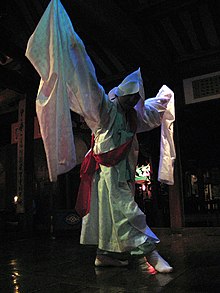Seungmu
| Seungmu | |
 |
|
| Korean name | |
|---|---|
| Hangul | 승무 |
| Hanja | 僧舞 |
| Revised Romanization | Seungmu |
| McCune–Reischauer | Sŭngmu |
Seungmu is a Korean dance performed by Buddhist monks. It is one of the most famous Korean traditional dances and designated as South Korea's important intangible cultural asset number 27 in 1969. It has been developed into a solo dance by professional dancers nowadays.
There is little extant evidence regarding how Seungmu was created. Based on analyses of forms and movements of Seungmu, some researchers have suggested that it may derived from other Buddhist ritual dances or ethnic or folk dances. Some said that Seungmu came from bubgo dance, a Buddhist ritual dance. It was once prohibited during the Joseon dynasty era, and then it was transformed into a folk dance and developed mostly by kisaengs.
The dancer wears a robe (jangsam) with long sleeve called gasa and white hood called (gokkal). The drum or bubgo is the most important part of Seungmu.
The seungmu integrates the eight rhythmic cycles: yeombul, dodeuri, taryeong, jajin taryeong, gutgeori, dwit gutgeori, gujeong nori, and saesanjo. Every now and then, when one rhythm shifts to another, the dancer changes the mood by changing his steps.
Some regard Seungmu as the most beautiful Korean dance, for the mixture of flowing movements and stillness. The dancer's long and white sleeves movements, the serenity of white hood, a breathtaking pause, and then a soul-stirring movement contribute to the singular uniqueness of the seungmu.
As with many of Korea's Intangible National Treasures, Seungmoo has been preserved by Human Cultural Treasures. Until recently, this dance was preserved by Master Lee Mae Bang, who recently passed away in 2015. Currently the position for next Human Cultural Treasure has yet to be decided by the Korean Government.
...
Wikipedia
